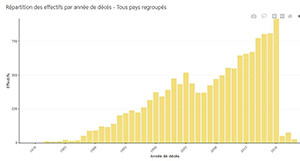Carlo-Giovanni Camarda, Arianna Caporali and Iris Hourani
INED researcher Carlo Giovanni Camarda, INED research engineer Arianna Caporali, and INED project manager Iris Hourani answer questions on the International Database on Longevity or IDL.
(Interview conducted June 2022)
What is the International Database on Longevity (IDL)?
The IDL database is a cooperative project begun in the 2000s that involves several international research institutes and researchers. The first version was completed in 2010 under the scientific direction of the Max Planck Institute for Demographic Research (MPIDR), INED, and INSERM. IDL brings together scientifically verified and validated data on individuals who died between the ages of 105 and 109—“semi-supercentenarians”—and others who died at the age of 110 or over, known as “supercentenarians.” For the first category, the verification procedure varies by country. In France, for instance, researchers use a sample to verify data. For supercentenarians, all countries proceed by systematically verifying each person’s birth certificate.
What are the objectives of this database?
The aim of the International Database on Longevity is to learn more about longevity and its limits, and to study the factors that have changed the trajectory of mortality over the years. The fall in mortality at very old ages and the phenomenon of supercentenarians are recent developments; the scientific community has been interested in them for twenty to thirty years now. It is important to study this population, whose numbers have risen.
How many countries have contributed data to IDL? What information is collected on semi- and supercentenarians? How many individuals are concerned?
The IDL database now contains information on deceased supercentenarians in 13 countries: Austria, Belgium, the Canadian province of Quebec, Denmark, England and Wales, Finland, France, Germany, Japan, Norway, Spain, Sweden, and the United States. With the exception of Finland, Sweden, Spain, and Japan, IDL also contains data on semi-supercentenarians.
The information on the 18,959 individuals currently in the base—determined in accordance with the laws of the different countries and anonymized before publication—includes sex, date of birth, date of death, number of years completed at death, places of birth and death (when available), and the way in which this information was validated.
INED launched a new version of the IDL in late May of this year. How was the database enhanced?
In the new version launched by INED in late May, data from some countries (Belgium, England and Wales, France) have been updated. Moreover, the base now has a data visualization tool that generates an overview; previously data could only be downloaded.
IDL operates consistent with the Open Science policy. The data is available to all researchers after registration on the website. The team working at INED on IDL has now provided scripts for the calculation algorithms used for some variables (e.g., years completed at death) to make them easier to use and provide partial explanations for of various data.
In the future, the team plans to increase the base’s geographic coverage to include aggregated—still rigorously validated—data on a greater number of countries.

